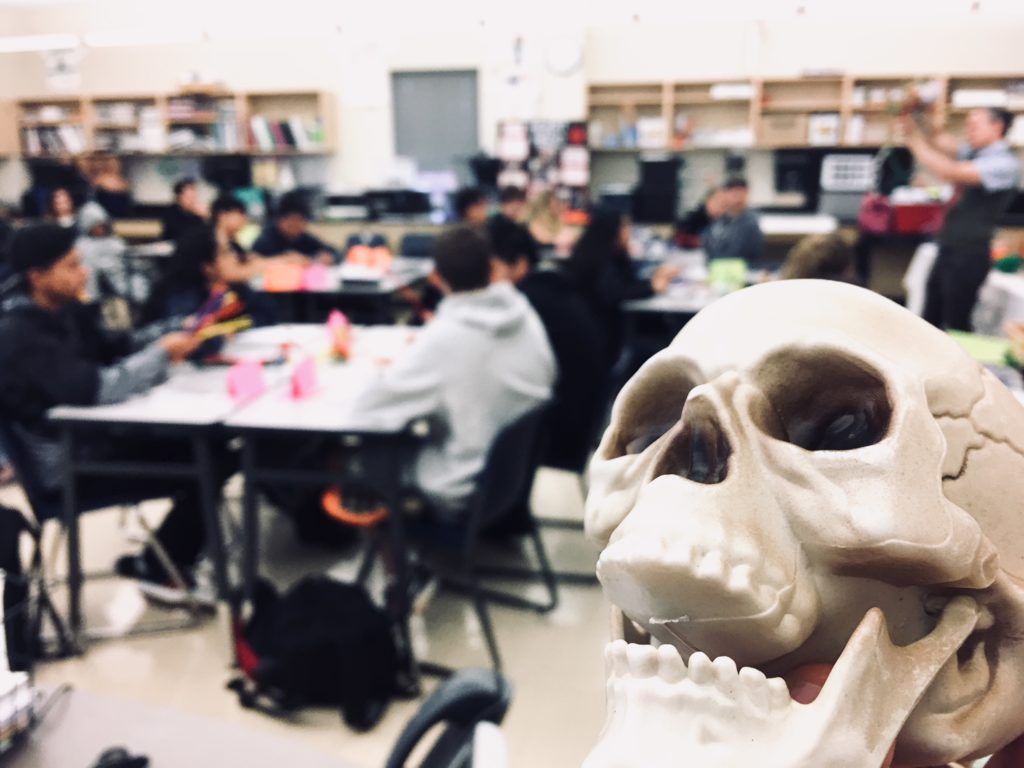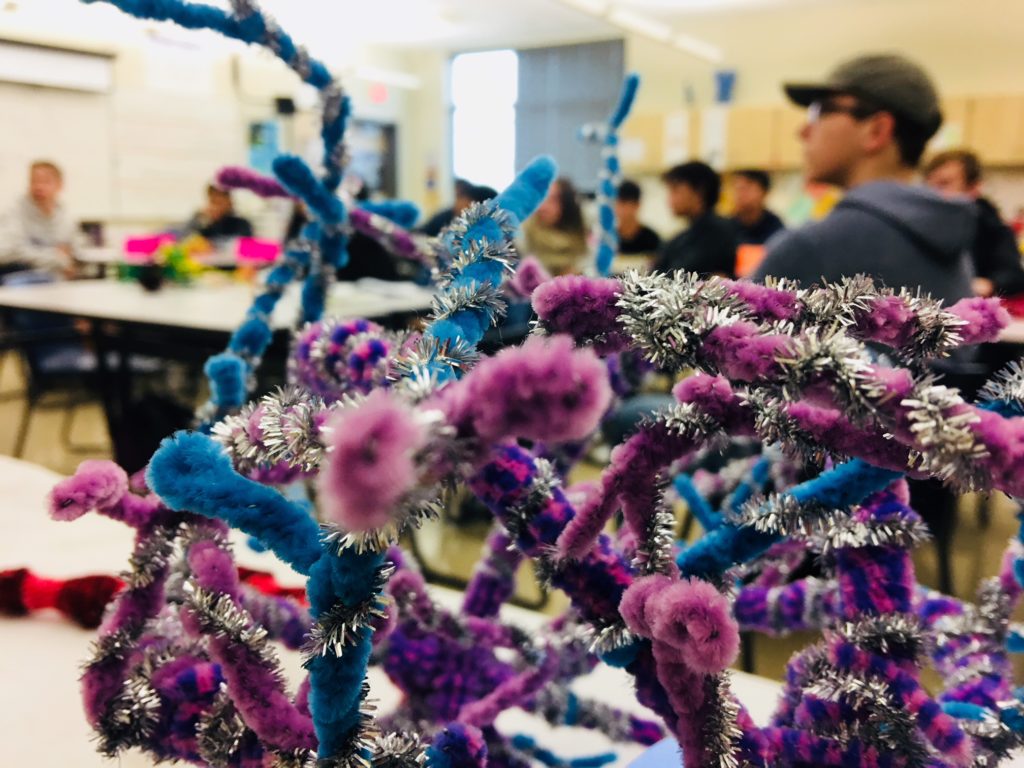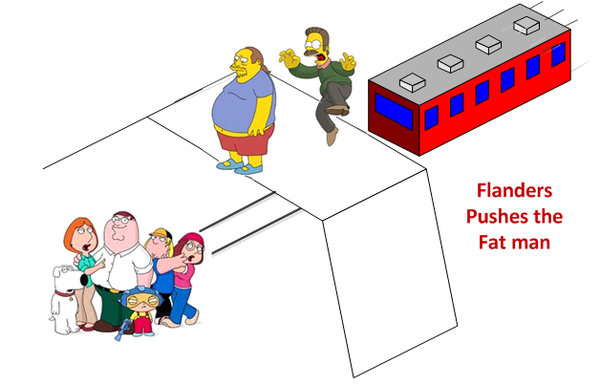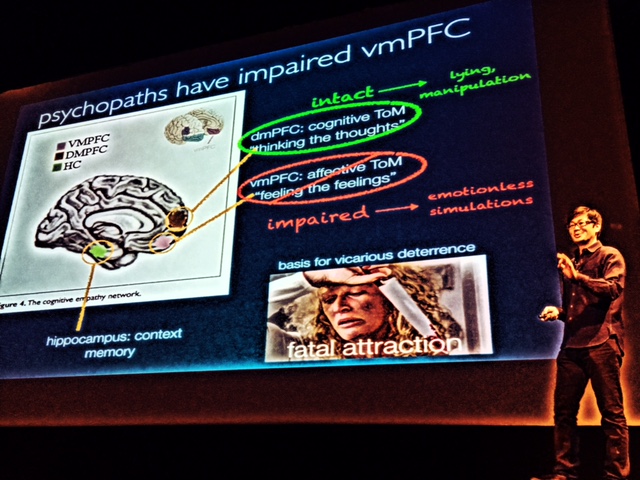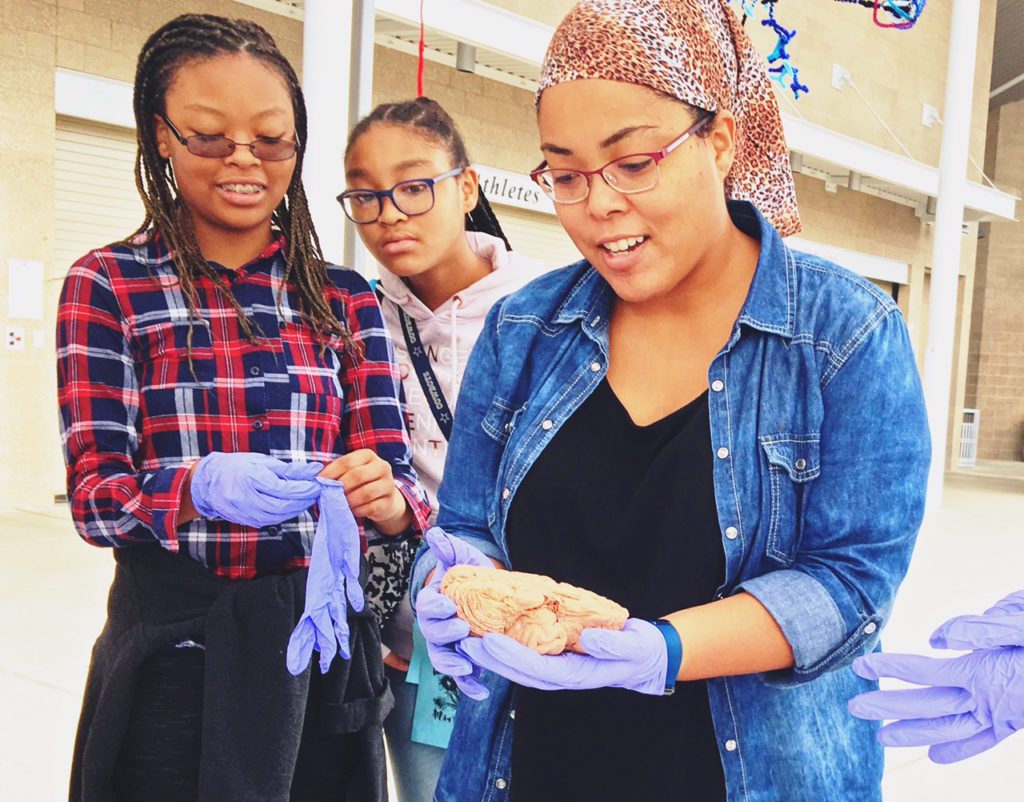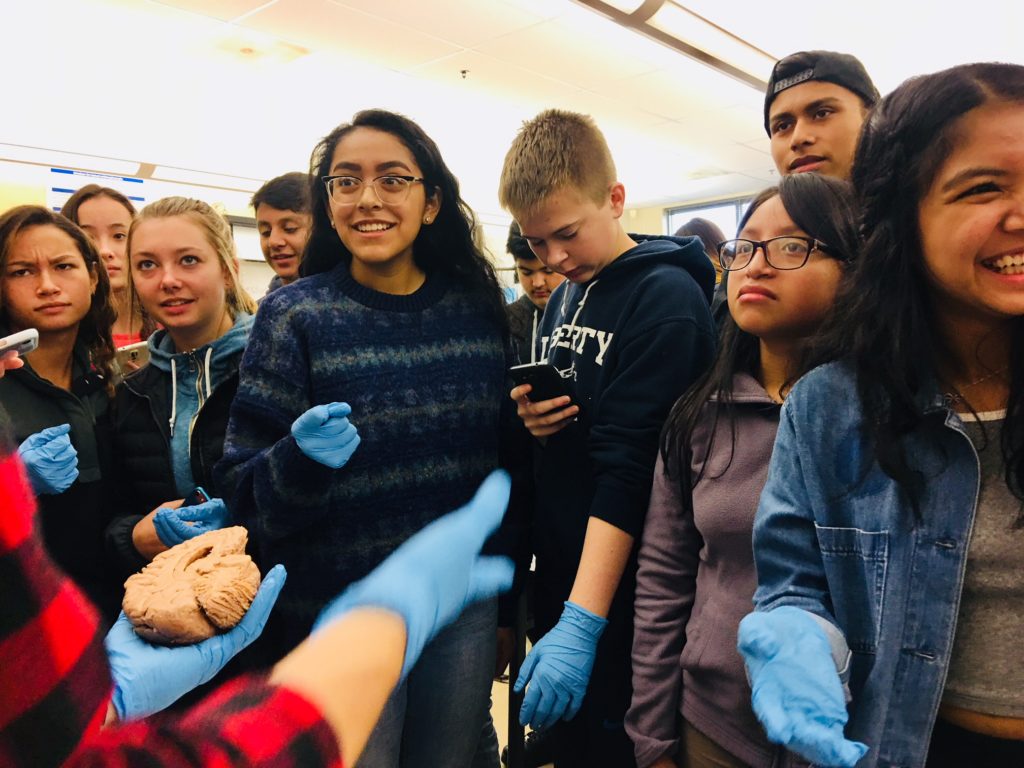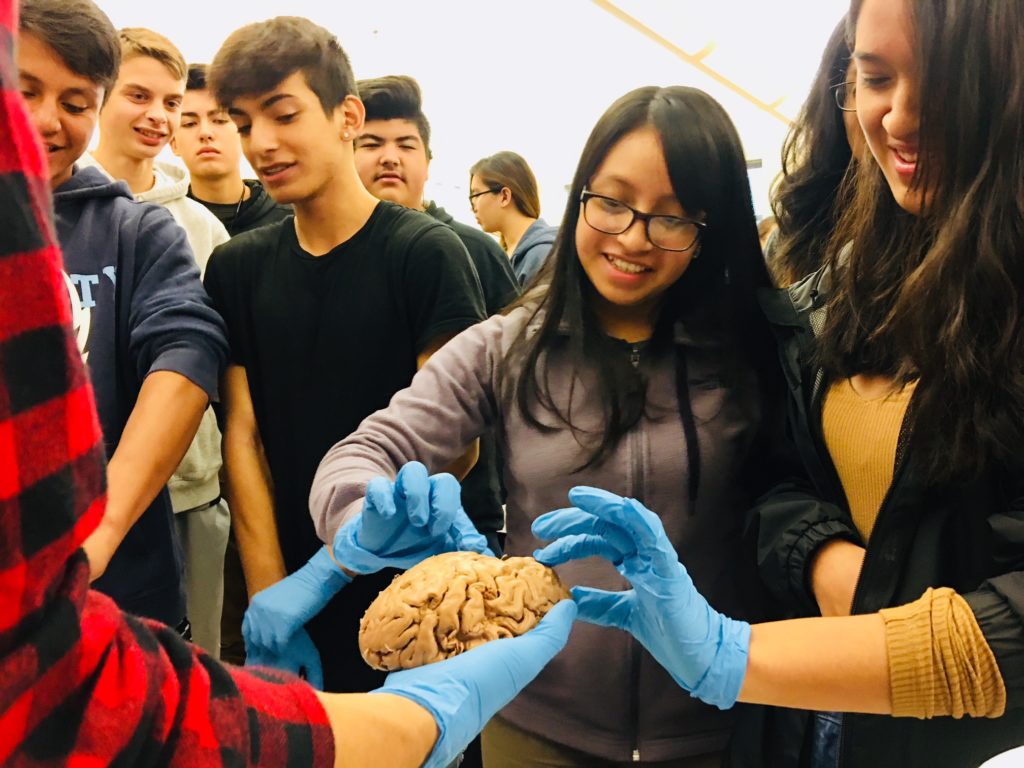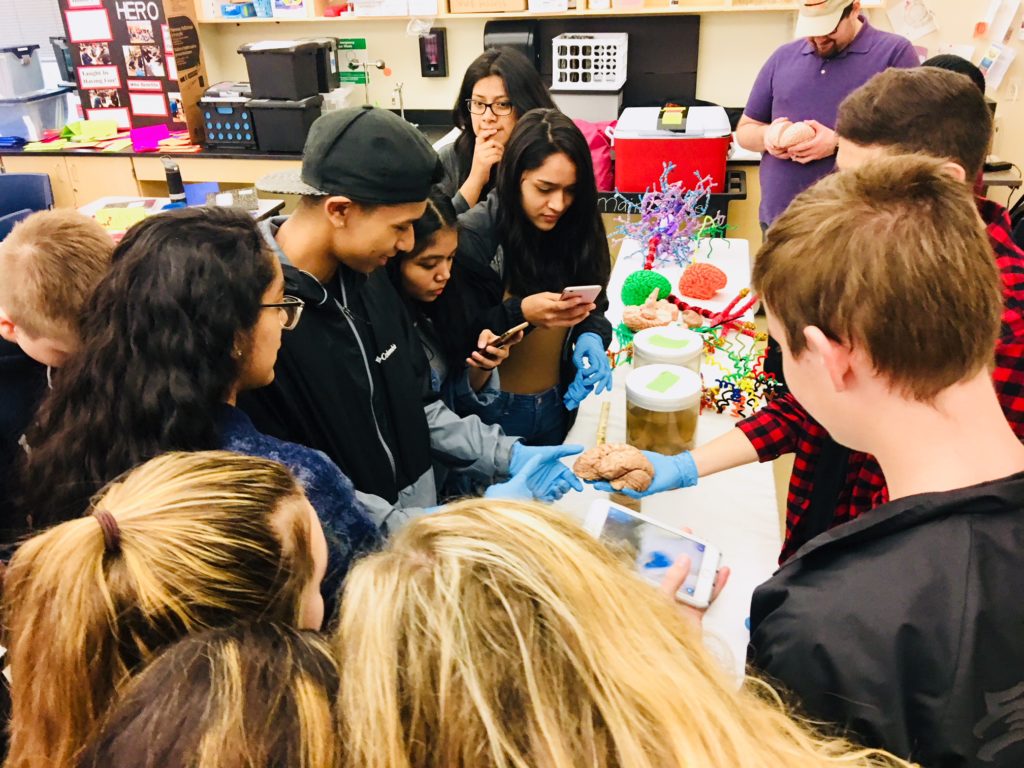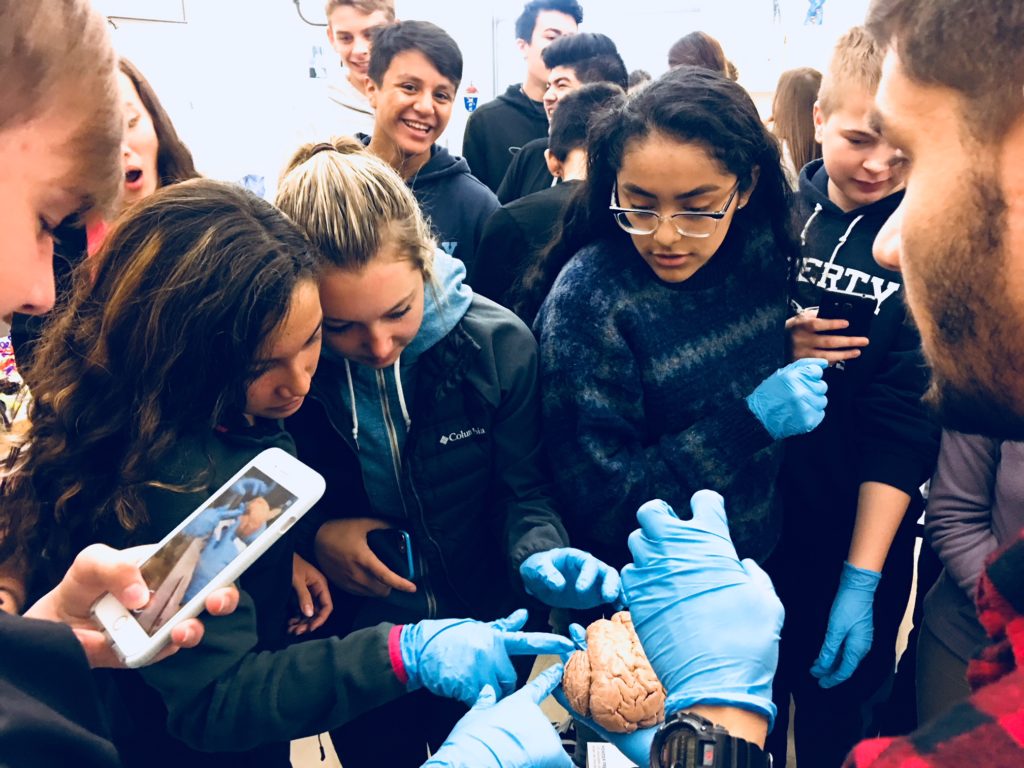Our Noggin volunteers tackled sclerotic commuter highways to meet with sleepy 10th graders at Liberty High School in Hillsboro Public Schools last week, early on a foggy autumn morning…
We were invited by Ramona Toth, the Health and Chemistry teacher at Liberty, whose classroom we’d visited previously on the same memorable day we’d explored cadaver labs at BioGift Anatomical, a Portland-based whole body donation and surgical education center that supports community outreach – and offered NW Noggin some new human brains..!
LEARN MORE: A BioGift of Brains
Last time we were also joined by Andrew Hardy, the BioGift Business Manager, who had introduced himself and his company’s work to the class. Andrew, we discovered, had been a student of Ramona’s in high school! We are particularly thrilled to return to BioGift next week for a second tour of their facilities, and to pick up yet another donated human cerebrum for multi-institutional outreach in our regional public schools!
Despite the early hour, students had terrific interest in sleep (!), racial bias, empathy, psychopathic behaviors and their relationship to social advancement, the nature of “common sense” and errors in thinking that lead us to mischaracterize or misunderstand situations – and also where they might go after high school for research, clinical and art careers…
Ramona wrote down details of our backgrounds as we described ourselves and discussed how we’d each arrived where we are now. Noggin volunteers included Joey Seuferling and Christina Williams, both active Noggin Resource Council members, and Travis Christian and Ali Mack from Psychology at Portland State University…
The questions surrounding sleep, bias and psychopathy were particularly fascinating. Research now clearly indicates substantial brain health benefits of later start times for high schools, as adolescents typically shift their circadian cycles later into the evening, and have more difficulty rising at an early hour.
LEARN MORE: Adolescent Changes in the Homeostatic and Circadian Regulation of Sleep
And this isn’t just lazy teenagers hitting the snooze bar on their alarms, but a notable biological stage in development where sleep deprivation has consequences. For example, schools with later start times have fewer students reporting mental health concerns. From one study: “for each additional hour of sleep reported, there was a 28% reduction in the adjusted odds of a participant reporting that he or she felt ‘unhappy, sad, or depressed.'”
LEARN MORE: Relationships between school start time, sleep duration, and adolescent behaviors
LEARN MORE: School Start Times, Sleep, Behavioral, Health, and Academic Outcomes: a Review of the Literature
Student were also very interested in recent work by Binyam Nardos at OHSU, who is investigating how seeing faces of different races impacts decision making in various social contexts – timely research that Binyam presented recently from the Noggin Fest stage…
LEARN MORE: Noggin Fest 2017!
LEARN MORE: New research looks at the influence of race and emotional context on face perception
LEARN MORE: Perceived Threat Associated with Police Officers and Black Men Predicts Support for Policing Policy Reform
Regarding psychopathy, one student asked about the “trolley problem,” a classic thought experiment involving a moral dilemma. You’re told that five people (and apparently one dog – see below) are working on a track, and are about to be killed by an oncoming train..!
But all five (six, including Brian Griffin from Family Guy!) could be saved, and by you – but only if you actively push the person next to you directly into the trolley’s path…
IMAGE SOURCE: Trolley Problems
Moral judgments involving emotional dilemmas are processed in distinct brain areas, including networks in the ventromedial pre-frontal cortex (vmPFC). In contrast, networks in dorsomedial prefrontal cortex (dmPFC) appear to process “cognitive” aspects of scenarios that let you predict what others might be thinking, allowing you to manipulate and respond to situations more effectively…
Psychopaths show less activity in the emotional vmPFC, but relatively normal activation of the dmPFC. While sacrificing one to save five might be the best outcome for this scenario, you wouldn’t want to stand next to the psychopath as that trolley hurtled by..!
LEARN MORE: Psychopathy & brains
LEARN MORE: How can studying psychopaths help us understand the neural mechanisms of moral judgment?
But who is a psychopath? There is a Psychopathy scale (PCL-R) developed by psychologist Robert Hare, which assesses behavioral traits associated with the diagnosis, though its validity has been challenged. Do psychopathic traits have any benefits? Students were curious about notorious corporate CEOs and political figures who cut jobs or harmed constituents to balance budgets or enrich themselves, without evident empathy for those affected by their decisions. Might these individuals benefit, and advance, partly through traits associated with psychopathy?
However, given rising inequality in our society, and increasing social segregation, it may be easier to fail at empathy for others when you don’t talk with or encounter people in different social groups – even for those with more “balanced” frontal lobes.
This is a powerful reason why we love taking our enthusiastic young volunteers from multiple universities off campus into public schools and spaces. A suburban classroom or lab with limited diversity, for example, doesn’t tell you who is in your community, or make you viscerally aware of, or responsive to, important issues and opportunities. You may not grasp how some decisions you make, or your institution makes, have consequences for others if you don’t see their faces, or even know they exist. “Let knowledge serve the City” is the motto of Portland State, and through Noggin we take it to heart!
And having worked in large institutions, we’ve certainly encountered a few insulated administrators who know little about the people they ostensibly serve, or the communities they work in – but are instead invested in splashy marketing campaigns replete with focus group tested slogans and expensive ad campaigns – but little substance. They develop endless goals, and sub-goals, and sub-sub-goals – but rarely set foot in classrooms or community, where real learning, connection and understanding occurs.
LEARN MORE: The Real Reason College Tuition Costs So Much
LEARN MORE: Administrator Hiring Drove 28% Boom in Higher-Ed Work Force
LEARN MORE: The Fall of the Faculty: The Rise of the All-Administrative University and Why It Matters
On this foggy morning at Liberty, we constructed some colorful brain cells of our own, using our much loved (and cheaply obtained) pipe cleaners!
And of course we also examined more of our donated human brains!
Many thanks to Ramona and her thoughtful students for welcoming us back to class!





